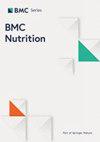Minimum acceptable diet and associated factors among 6–23 months children in rural households with irrigated users and non-irrigated users in Ethiopia: a comparative cross-sectional study
IF 2.2
Q3 NUTRITION & DIETETICS
引用次数: 0
Abstract
Poor quality of complementary foods is a key contributor to undernutrition even with optimal breastfeeding. Minimum Acceptable Diet (MAD) has tremendous health and nutrition benefits but only 12% of Ethiopian children’s feeding practices meet its standards. The Ethiopian government has recently increased efforts to expand nutrition-sensitive irrigation to improve child nutrition. However, the impact that irrigation has brought on the minimum acceptable diet practice of children below two years has not yet been studied. The aim of this study was to compare the magnitude of MAD practice and associated factors among children aged 6–23 months in households with irrigated users and non-users of North Mecha district, Ethiopia. A community-based comparative cross-sectional study was employed among 824 mother-child pairs. For infant and young child feeding practices, the data collection tools were adapted from the World Health Organization’s standardized questionnaire developed in 2010. X2 test was used to compare the MAD practices of irrigated users’ and non-irrigated users. Bivariate and multivariable logistic regression analyses were performed to see the predictor variables. p-value < 0.05 was taken to declare statistical significance. The present study showed that the MAD practice of under two children in irrigated users is significantly higher than non-users (X2 = 13.91, P <.001). Maternal involvement in decision-making [AOR = 4.37, 95% CI: (2.05,9.33)], initiation of breastfeeding [AOR = 5.29, 95% CI: (2.393,11.672)], and history of illness [AOR = 4.10, 95%CI: (1.48,11.38)] were independent predictors for MAD practice among irrigated users. Whereas, maternal involvement in decision making [AOR = 4.71, 95% CI: ( 2.28, 9.75)], place of delivery [AOR = 2.51, 95% CI: ( 1.14, 5.55)], postnatal care (PNC) follow-up [AOR = 3.01, 95%CI: (1.57, 5.77)] and growth monitoring and promotion (GMP) service utilization [AOR = 4.64, 95% CI: (2.40, 8.95)] were the independent predictors among the non-users. MAD practice was much higher in irrigated users than in non-irrigated users. Involvement in a decision, place of delivery, PNC, and GMP are independent predictors of MAD in children from non-irrigated households. The study suggested that expanding access to irrigation to households may be the best approach to improve child nutrition.埃塞俄比亚灌溉用户和非灌溉用户农村家庭中 6-23 个月儿童的最低可接受饮食标准及相关因素:一项横断面比较研究
即使母乳喂养达到最佳效果,辅食质量差也是造成营养不良的主要原因。最低可接受膳食(MAD)具有巨大的健康和营养益处,但只有 12% 的埃塞俄比亚儿童的喂养方式符合其标准。埃塞俄比亚政府最近加大力度扩大对营养敏感的灌溉,以改善儿童营养状况。然而,灌溉对两岁以下儿童最低可接受饮食做法的影响尚未得到研究。本研究旨在比较埃塞俄比亚北梅查区灌溉用户家庭和非灌溉用户家庭中 6-23 个月大儿童的最低可接受膳食做法的程度及相关因素。该研究以社区为基础,对 824 对母婴进行了横断面比较研究。在婴幼儿喂养方式方面,数据收集工具改编自世界卫生组织于 2010 年开发的标准化问卷。采用 X2 检验比较灌溉用户和非灌溉用户的婴幼儿喂养方式。对预测变量进行了二元和多元逻辑回归分析。本研究表明,灌溉用户对两名以下儿童的 MAD 实践明显高于非用户(X2 = 13.91,P <.001)。母亲参与决策[AOR = 4.37,95% CI:(2.05,9.33)]、开始母乳喂养[AOR = 5.29,95% CI:(2.393,11.672)]和病史[AOR = 4.10,95%CI:(1.48,11.38)]是灌溉使用者实施 MAD 的独立预测因素。而产妇参与决策[AOR = 4.71, 95% CI: ( 2.28, 9.75)]、分娩地点[AOR = 2.51, 95% CI: ( 1.14, 5.55)]、产后护理(PNC)随访[AOR = 3.01, 95%CI: (1.57, 5.77)]和生长监测与促进(GMP)服务利用率[AOR = 4.64, 95% CI: (2.40, 8.95)]则是非灌溉用户中使用 MAD 的独立预测因素。灌溉用户的 MAD 实践远高于非灌溉用户。参与决策、分娩地点、PNC 和 GMP 是非灌溉家庭儿童 MAD 的独立预测因素。研究表明,扩大家庭灌溉可能是改善儿童营养状况的最佳方法。
本文章由计算机程序翻译,如有差异,请以英文原文为准。
求助全文
约1分钟内获得全文
求助全文
来源期刊

BMC Nutrition
Medicine-Public Health, Environmental and Occupational Health
CiteScore
2.80
自引率
0.00%
发文量
131
审稿时长
15 weeks
 求助内容:
求助内容: 应助结果提醒方式:
应助结果提醒方式:


